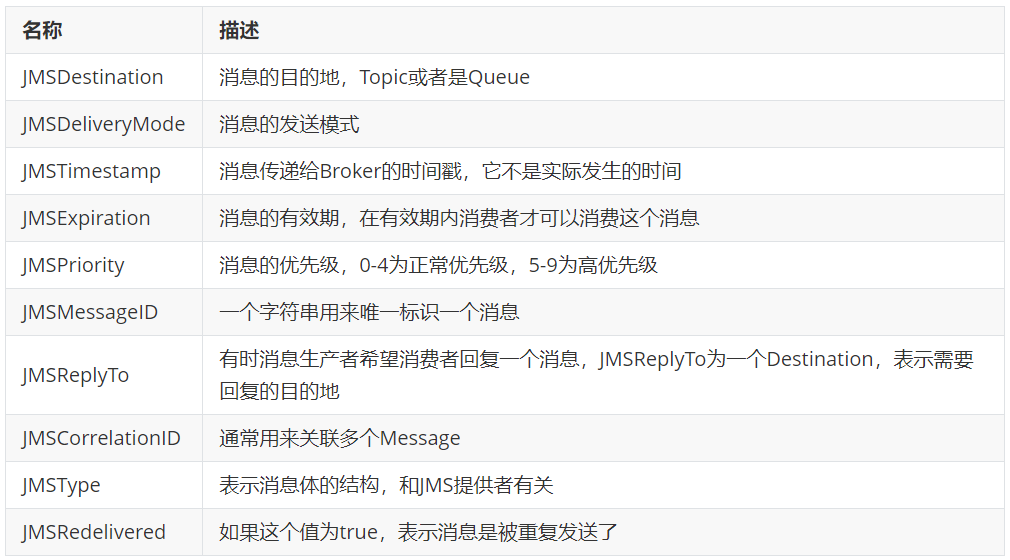Apache ActiveMQ是当前最流行的开源的,支持多协议的,基于Java的消息中间件,官网的原话是:Apache ActiveMQ™ is the most popular open source, multi-protocol, Java-based messaging server.
ActiveMQ是一个完全支持JMS1.1和J2EE规范的JMS Provider实现,尽管JMS规范出台已经是很久的事情了,但是JMS在当今J2EE应用中仍扮演者特殊的地位。
JMS是什么
JMS全称Java Message Service,即Java消息服务应用程序接口,是一个Java平台中关于面向消息中间件(MOM)的API,用于在两个应用程序之间,或分布式系统中发送消息,进行异步通信。Java消息服务是一个与具体平台无关的API。
JMS对象模型
JMS消息模型
在JMS标准中,有两种消息模型PTP(Point to Point)以及Publish/Subscribe(Pub/Sub)。
PTP,点对点消息传送模型
在点对点消息传送模型中,发送者将消息发送给一个特殊的消息队列,该队列保存了所有发送给它的消息,消费者从这个队列中获取消息。
PTP的特点:
- 每个消息只有一个消费者,即一旦被消费,消息就不再在消息队列中
- 发送者和接收者之间在时间上没有依赖性,也就是说当发送者发送了消息之后,不管接收者有没有正在运行,都不会影响到消息被发送到队列
- 接收者在成功接收消息之后需向队列发送确认收到通知
Pub/Sub,发布/订阅消息传递模型
在发布/订阅消息模型中,发布者发布一个消息,该消息通过topic传递给所有的客户端。在这种模型中,发布者和订阅者彼此不知道对方,是匿名的且可以动态发布和订阅topic。在发布/订阅消息模型中,目的地被称为主题(topic),topic主要用于保存和传递消息,且会一直保存消息直到消息被传递给客户端。
Pub/Sub特点:
- 每个消息可以有多个消费者
- 发布者和订阅者之间有时间上的依赖性。针对某个topic的订阅者,它必须创建一个或多个订阅者之后,才能消费发布者的消息,而且为了消费消息,订阅者必须保持运行的状态。
- 为了缓和这样严格的时间相关性,JMS允许订阅者创建一个可持久化的订阅,这样就可以在订阅者没有运行的时候也能接收到发布者的消息
JMS消息结构
Message主要由三部分组成,分别是消息头Header,消息属性Properties,以及消息体Body。
消息头中主要内容:
消息属性可以理解为消息的附加消息头,属性名可以自定义。消息的属性值可以是String, boolean , byte,short, double, int ,long或float型,Message接口为读取和写入属性提供了若干个取值函数和赋值函数方法。
消息体的类型:
ActiveMQ的特性
- 支持多种编程语言
- 支持多种传输协议
- 有多种持久化方式
ActiveMQ的安装
安装环境:JDK1.8,CentOS7
下载地址:http://activemq.apache.org/components/classic/download/
CentOS在连网的情况下也可以通过wget(如果wget命令不存在可以通过yum install wget进行安装)命令获取软件包,如:wget https://archive.apache.org/dist/activemq/5.15.10/apache-activemq-5.15.10-bin.tar.gz
提取文件: tar -zxvf apache-activemq-5.15.10-bin.tar.gz -C /vartar -zxvf apache-activemq-5.15.10-bin.tar.gz -C /var
重命名:mv /var/apache-activemq-5.15.10/ /var/activemq/
ActiveMQ解压后的目录结构:

在/etc/profile文件中添加Java环境变量:
export JAVA_HOME=/var/jdk1.8.0
export PATH=$JAVA_HOME/bin:$PATH
export CLASSPATH=.:$JAVA_HOME/lib/dt.jar:$JAVA_HOME/lib/tools.jar
ActiveMQ解压后就可以使用,bin目录下可执行activemq可以进行ActiveMQ的启动停止。
ActiveMQ服务
前面使用命令运行ActiveMQ,但最好的方式是将ActiveMQ作为服务启动,使用system服务可以保证ActiveMQ在系统启动时自动启动。
创建ActiveMQ服务步骤:
- 创建一个systemd服务文件:
vi /usr/lib/systemd/system/activemq.service
- 在服务文件中添加以下内容
[Unit]
Description=ActiveMQ service
After=network.target
[Service]
Type=forking
ExecStart=/var/activemq/bin/activemq start
ExecStop=/var/activemq/bin/activemq stop
User=root
Group=root
Restart=always
RestartSec=9
StandardOutput=syslog
StandardError=syslog
SyslogIdentifier=activemq
[Install]
WantedBy=multi-user.target
- 产看Java安装目录:whereis java
- 设置activemq配置文件/var/activemq/bin/env中的JAVA_HOME
# Location of the java installation
# Specify the location of your java installation using JAVA_HOME, or specify the
# path to the "java" binary using JAVACMD
# (set JAVACMD to "auto" for automatic detection)
JAVA_HOME="/var/jdk1.8.0"
JAVACMD="auto"
- 通过systemctl管理activemq启停
- 启动activemq服务:systemctl start activemq
- 查看服务状态:systemctl status activemq
- 创建软件链接:ln -s /usr/lib/systemd/system/activemq.service /etc/systemd/system/multi-user.target.wants/activemq.service
- 开机自启:systemctl enable activemq
- 检测是否开启成功:systemctl list-unit-files |grep activemq
- 停止activemq服务:systemctl stop activemq
ActiveMQ的Web管理平台
ActiveMQ自带有Web管理平台,默认使用8161端口,服务启动后在浏览器输入http://服务IP:8161/admin 即可进入,默认配置的账户admin,密码也是admin。
如果服务启动后页面无法访问可能是防火墙内需要添加需要的端口。
查看防火墙状态:systemctl status firewalld
防火墙添加端口:firewall-cmd —zone=public —add-port=61616/tcp —permanent
重启防护墙:systemctl restart firewalld.service
或者直接关闭防火墙:systemctl stop firewalld.service
ActiveMQ的Web管理平台是基于jetty的,在ActiveMQ的安装目录下conf文件中有jetty.xml配置文件,通过该文件可以对Web管理平台进行配置管理, 如:
<bean id="jettyPort" class="org.apache.activemq.web.WebConsolePort" init-method="start">
<!-- the default port number for the web console -->
<property name="host" value="0.0.0.0"/>
<!--此处即为管理平台的端口-->
<property name="port" value="8161"/>
</bean>
<bean id="securityConstraint" class="org.eclipse.jetty.util.security.Constraint">
<property name="name" value="BASIC" />
<property name="roles" value="user,admin" />
<!-- 改为false即可关闭登陆 -->
<property name="authenticate" value="true" />
</bean>
通过jetty-realm.properties配置文件可以对Web管理平台的用户进行管理:
# 在此即可维护账号密码,格式:
# 用户名:密码,角色
# Defines users that can access the web (console, demo, etc.)
# username: password [,rolename ...]
admin: admin, admin
user: 1234, user
ActiveMQ的Java示例
Maven管理的Jar包:
<dependency>
<groupId>org.apache.activemq</groupId>
<artifactId>activemq-all</artifactId>
<version>5.15.10</version>
</dependency>
Producer代码示例:
package com.demo.queue;
import org.apache.activemq.ActiveMQConnectionFactory;
import javax.jms.*;
public class ProducerDemo {
private static final String BORKER_URL = "tcp://ip:61616";
private static final String QUEUE_NAME = "queue-test";
public static void main(String[] args) throws Exception {
// 创建连接工厂
ActiveMQConnectionFactory activeMQConnectionFactory =
new ActiveMQConnectionFactory("admin", "admin", BORKER_URL);
// 创建连接对象
Connection connection = activeMQConnectionFactory.createConnection();
connection.start();
// 创建会话
Session session = connection.createSession(false, Session.AUTO_ACKNOWLEDGE);
// 创建点对点发送的目标Queue
Queue queue = session.createQueue(QUEUE_NAME);
// 创建消息生产者
MessageProducer producer = session.createProducer(queue);
// Topic topic1 = session.createTopic("topic-test");
// MessageProducer producer1 = session.createProducer(topic1);
// 设置生产者的模式,有两种可选 持久化 / 不持久化
producer.setDeliveryMode(DeliveryMode.PERSISTENT);
// 文本消息
TextMessage message = session.createTextMessage("Hello ActiveMQ message");
// 发送消息
producer.send(message);
// 关闭连接
producer.close();
session.close();
connection.close();
}
}
运行之后可以在Web控制台Queues tab下看到消息:
Consumer代码示例:
package com.demo.queue;
import org.apache.activemq.ActiveMQConnectionFactory;
import javax.jms.*;
public class ConsumerDemo {
private static final String BORKER_URL = "tcp://192.168.0.242:61616";
private static final String QUEUE_NAME = "queue-test";
public static void main(String[] args) throws Exception {
// 创建连接工厂
ActiveMQConnectionFactory activeMQConnectionFactory = new ActiveMQConnectionFactory(BORKER_URL);
// 创建连接对象
Connection connection = activeMQConnectionFactory.createConnection("admin", "admin");
connection.start();
// 创建会话
Session session = connection.createSession(false, Session.AUTO_ACKNOWLEDGE);
// 创建点对点消费的目标Queue
Queue queue = session.createQueue(QUEUE_NAME);
// Topic topic1 = session.createTopic("topic-test");
// MessageConsumer consumer1 = session.createConsumer(topic1);
// 创建消息消费者
MessageConsumer consumer = session.createConsumer(queue);
// 接收消息
Message message = consumer.receive();
if (message instanceof TextMessage) {
System.out.println("收到文本消息:" + ((TextMessage) message).getText());
} else {
System.out.println(message);
}
// 关闭连接
consumer.close();
session.close();
connection.close();
}
}
运行后可以看到消息被消费:
SpringBoot中使用ActiveMQ的代码示例
Maven依赖:
<dependency>
<groupId>org.springframework.boot</groupId>
<artifactId>spring-boot-starter-activemq</artifactId>
</dependency>
yml配置文件:
spring:
activemq:
broker-url: tcp://ip:61616
user: admin
password: admin
代码示例:
import org.apache.activemq.command.ActiveMQTopic;
import org.springframework.beans.factory.annotation.Autowired;
import org.springframework.boot.SpringApplication;
import org.springframework.boot.autoconfigure.SpringBootApplication;
import org.springframework.jms.core.JmsTemplate;
import javax.annotation.PostConstruct;
@SpringBootApplication
public class Producer {
@Autowired private JmsTemplate jmsTemplate;
@PostConstruct
public void init() {
ActiveMQTopic activeMQTopic = new ActiveMQTopic("topic-test");
jmsTemplate.convertAndSend(activeMQTopic, "Hello SpringBoot ActiveMQ!");
}
public static void main(String[] args) {
SpringApplication.run(Producer.class);
}
}
import org.springframework.boot.SpringApplication;
import org.springframework.boot.autoconfigure.SpringBootApplication;
import org.springframework.context.annotation.Bean;
import org.springframework.jms.annotation.EnableJms;
import org.springframework.jms.annotation.JmsListener;
import org.springframework.jms.config.JmsListenerContainerFactory;
import org.springframework.jms.config.SimpleJmsListenerContainerFactory;
import javax.jms.ConnectionFactory;
@EnableJms
@SpringBootApplication
public class Consumer {
@Bean
public JmsListenerContainerFactory<?> myFactory(ConnectionFactory connectionFactory) {
SimpleJmsListenerContainerFactory factory = new SimpleJmsListenerContainerFactory();
factory.setConnectionFactory(connectionFactory);
factory.setPubSubDomain(true);
return factory;
}
@JmsListener(destination = "topic-test", containerFactory = "myFactory")
public void receive(String message) {
System.out.println("Received Message: " + message);
}
public static void main(String[] args) {
SpringApplication.run(Consumer.class);
}
}








